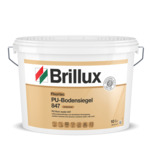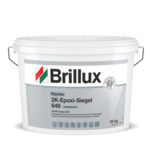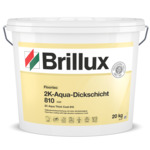Testing, product selection & coating Sealing vs. coating
What is the difference between a sealing and a coating? With sealing, a covering application seals the pores of the floor completely. The layer thicknesses are between 0.1 and 0.3 mm after multiple roller or brush coats. Sealing significantly reduces the wear and the dust formation and improves the cleanability of the surface in the event of soiling. Depending on the composition of the sealing, these floors have a good resistance to chemicals – but a relatively thin wear layer. This measure therefore only provides limited suitability for mechanical stress in commercial areas. Synthetic resin dispersions and reactive resins in solvent-based or solvent-free quality are used for sealing. A colored floor design is also possible by means of pigmentation or interspersed decochips.
High level of protection via coating
Coatings with thicknesses between 0.3 and 5 mm can withstand mechanical and chemical stresses in wet and dry areas. We differentiate between two application methods here: thin coatings applied with a roller and self-leveling thick coatings applied with a trowel or squeegee. The material properties and application method enable the coating to self-level. The result: an extremely uniform surface with a high protective effect – specifically coordinated to suit the specific requirements on-site.
Testing and preparation
The different substrates
Every floor is made up of a base course layer and a wear layer. They must be bonded to each other so that the floor retains lasting functionality. It is also important that both layers are optimally suited to the future mechanical and chemical stresses in their application site. The key to a successful floor renovation is therefore to identify and assess the substrate correctly.
| Concrete | Cement screed | Magnesia screed | Anhydrite screed (calcium sulphate screed) | Cast asphalt | |
|---|---|---|---|---|---|
| Short name in accordance with EN 13813 | C (concrete) | CT (cementitious screed) | MA (magnesite screed) | CA (calcium sulfate screed) | AS (mastic asphalt screed) |
| Bonding agent | Cement | Cement | Water-free magnesium chloride with magnesium oxide | Water-free calcium sulfate (CaSO4) | Bitumen |
| Color shade | Gray or slightly bluish | Gray | Natural white or colored through with metallic oxide pigments, e.g. gray, red, yellow, green | Natural white/beige | Black |
| Characteristics | Ideal substrate for sealers and coatings. Concrete can have extremely high strength values | Most frequently used screed type. Different implementation versions, e.g. as sloping screed, heating screed or leveling screed, as bonded screed or separating layer | Low-tension floating screed, withstands high mechanical stress, but is sensitive to moisture and therefore not suitable for wet and exterior areas | Low-tension floating screed on film separating layer. Is sensitive to moisture and therefore not suitable for wet and exterior areas and can only be used in conjunction with a coating, sealer, or floor covering | Thermoplastic, watertight, cavity-free and almost vapor-diffusion proof. Usually on a paper separating layer. Jointless installation over even large areas possible. Very fast application. |
| Surface | Smooth to rough, partially surface finished | Smooth or brush-rough, partially surface treated | Smooth, aftertreated with wax or dispersion-based maintenance products | Smooth | Smooth, sanded down with grain size 0.6–1.2 mm |
| Layer thickness | Variable, min. 5 cm | 3–5 cm | 1.5–2.5 cm | 3–5 cm | 2–4 cm |
| Grain size of the aggregates | 0–35 mm | 0–8 mm | 0–2 mm | 2–8 mm | 0–2 mm |
| Field of application | Industrial halls, private or commercial areas | Private and commercial areas | For special requirements on noise and heat insulation or high mechanical stress | Residential construction, office and administration areas | Residential construction and industrial areas |
| Residual moisture CM-% | 2.5–3.5 | 2.5–3.5 | 3–12 | 0.5 | - |
| Max. residual moisture CM-% | 4 | 4 | 12 | 0.5 | - |
| Drying time after installation | 4–8 weeks | 4–8 weeks | Approx. 3 weeks | Approx. 4 weeks | 2–3 hours |
First step to the perfect coating: Testing
a) Determine the soil moisture The functionality of a floor coating depends on the moisture content of the substrate. The most reliable way to determine this is with a CM device (calcium carbide method). A moisture content of more than 4 percent by weight in the concrete, for example, requires special systems for additional coating. Depending on the coating system, the substrate must not exceed the following maximum moisture values:
- Concrete: approx. 4 percent
- Cement screed: approx. 4 percent
- Magnesia screed: approx. 12 percent
- Anhydrite screed: approx. 0.5 percent
b) Measurement of the tear strength To determine the surface strength, a scratch test is performed first as orientation – followed by measurement of the tear strength. The scratch test shows whether the strength of the base course layer is sufficient or inadequate, e.g. sintered layers. Tear tests are then the only way to obtain meaningful values. Multiple measurements are always performed for certainty: The smallest measured value should not be less than 1 N/mm² – the mean value should reach 1.5 N/mm². c) Compressive strength test The compressive strength of the concrete or screed can be measured with the rebound hammer. This shows whether the floor will withstand future mechanical stresses.
| Concrete | Cement screed | Magnesia screed | Anhydrite screed | |
|---|---|---|---|---|
| Simple walking load, light vehicular stress | C 20/25 (B 25) | CT 30 | MA 30 | CA 30 |
| Increased stress/forklift traffic or something similar similar | C 30/37 (B 35) | CT 40 | MA 40 | CA 40 |
Everything at a glance: core drilling
For substrates penetratedby moisture from the rear or extremely oily and contaminated, or if the floor constructions have not been determined, core drilling is recommended. The cross section clarifies everything: Structure, strength, level of oil contamination etc.
Second step: surface preparation
For a coating to adhere reliably, the substrate must be dry, stable, free from grease, and exhibit good adhesiveness. The higher the stress on the floor and the more elaborate the coating system, the more thorough the pretreatment should be: Dirt, oil, grease, dust and abrasion, old coatings that are no longer load-bearing, chemicals and other contaminants must be removed completely. This also applies for crumbling surfaces, sintered layers and cement slurry. Small areas can be roughened with suitable abrasives, steel brushes, or mechanically rotating brushes. The area must then be cleaned thoroughly and freed from dust with an industrial vacuum cleaner. However, sanding and brushing is not suitable for all substrates and coating systems: For highly compacted, power smoothed concrete surfaces and substrates treated with thick coating systems, shot blasting is the correct preparation method.
Milling
Several millimeters of a surface can be removed efficiently with this method. Milling is effective for old coatings and reactive resin coatings, for example. Then: Rework surfaces with dust-free shot blasting.
Shot blasting method
With the so-called Blastrac method, also known as dust-free shot blasting, steel balls are blasted onto the floor using a shot blasting machine. The removed material is vacuumed up, and the steel balls are fed back into the shot blasting machine. This method is practically dust-free. In many cases, the rooms can be used during the surface preparation.For more safety
Slip resistance
Flooring surfaces in work rooms and work areas must be slip-resistant. This is stipulated by the German Workplace Ordinance and the Accident Prevention Regulations (UVV) "General Regulations" (BGV A1, previously VBG 1). For the specified slip-resistance requirements, including in areas with slip hazards, Brillux offers additives for most sealers and coatings, such as Floortec Safe Step 841 or Floortec Quartz Sand 1526.
Observe the Slip Resistance Class
The level of slip-resistance is defined by the "Slip Resistance Class" in accordance with the BG regulation 181 "Floors in working spaces and work areas with danger of slipping" and the test standard DIN 51130. For wet barefoot areas, the test is performed in accordance with DIN 51097 according to BGI/GUV-I 8627. Which Brillux coating system fulfills which Slip Resistance Class? An overview:
| Slip Resistance Class | Key figure displacement space | Coating system |
|---|---|---|
| R 9 |
| Floortec 2K-Aqua Thick Coat 810 |
| R 10 | Floortec 2K-Epoxi-Sealant 848 with Floortec Safe Step 841 | |
| R 11 | V4 | Floortec 2K-EP Thick Coat 894, filled with Floortec Quartz Sand 1526 (0.1–0.4 mm), scattered with Floortec Quartz Sand 1526 (0.2–0.7 mm) and 550 g/m² sealer Floortec 2K-Purolid F 878, silk matt with Floortec Safe Step 841, as top seal |
| R12 | Floortec Topcon T 829 with Floortec Colorgrains 830 and as top seal | |
| R12 | V4 | Floortec 2K-EP Thick Coat 894, filled with Floortec Quartz Sand 1526 (0.1–0.4 mm), scattered with Floortec Quartz Sand 1526 (0.2–0.7 mm) and 450 g/m² sealer |











